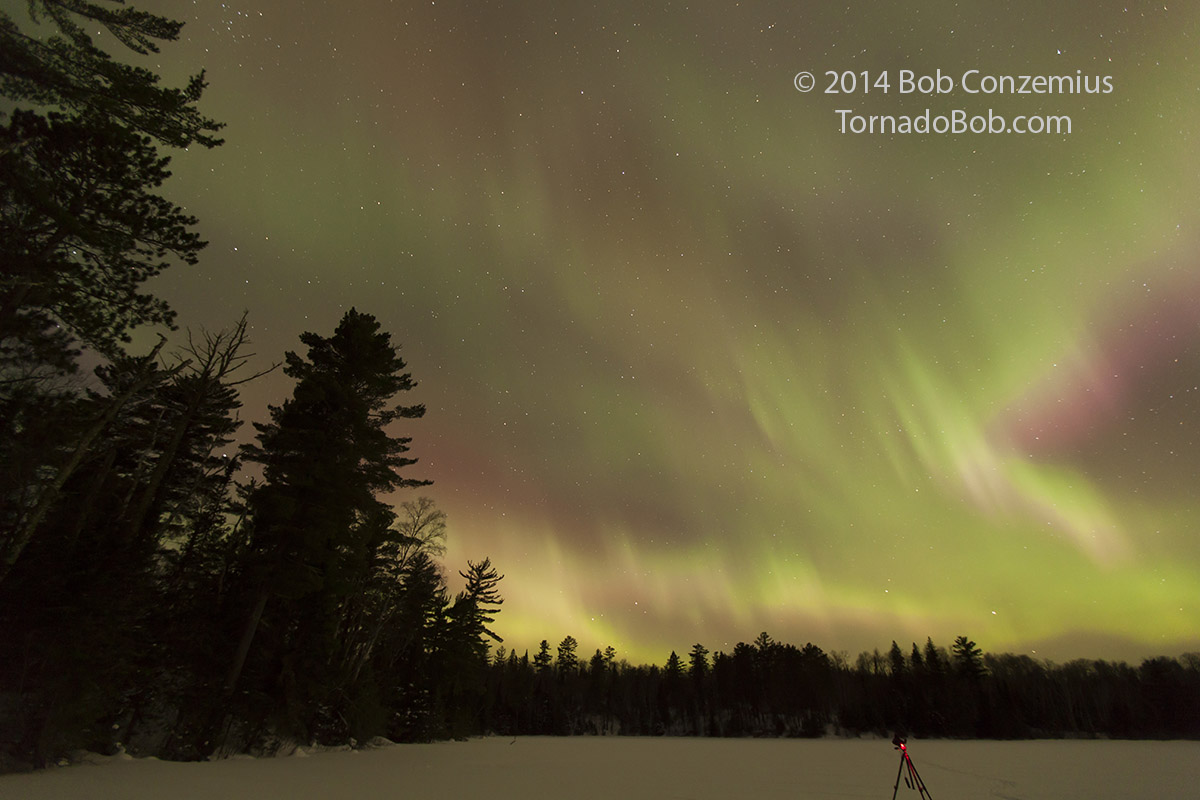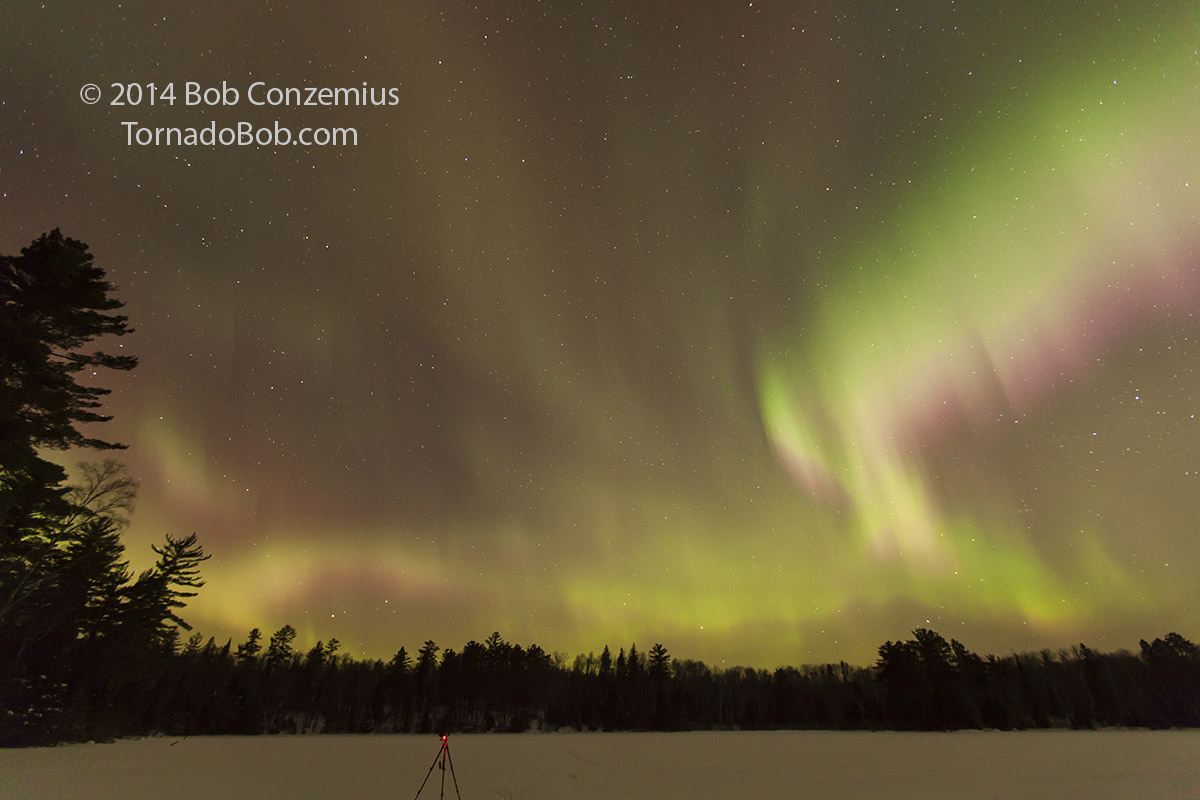St. Patrick's Day Auroras
Orange Lake, Chippewa National Forest
A strong, magnetically complex sunspot group (AR 1678) developed on February 19 on the Earth-facing side of the sun, but it failed to produce a strong flare until it got just behind the western limb and started its journey around the far side. I was a bit disappointed at this, as most sunspot groups this cycle had not lasted long enough to make it back around to face Earth again. This one was different. On March 9, the sunspot group reemerged on the eastern limb as AR 1692. On March 15, a filament eruption around this complex sunspot group hurled a coronal mass ejection (CME) towards Earth.
It was March, so you'd normally be thinking Spring, but the spring of 2013 was more like winter. I had a St. Urho's Day party to attend with some friends on the evening of the 16th, and I was constantly on the phone (much to their chagrin) to check for the CME impact. The impact didn't come during the party as I had anticipated, so I went home to bed. I thought I should set my alarm to awaken me in a couple hours to check again for the CME, but I realized the Spaceweather.com text alert would come over my phone in the event of a strong CME impact (which this was expected to be), so I decided the text alert would awaken me instead.
I must have slept through the alert because after a couple hours of fitful sleep, I awoke after 2:00 AM to see that the text alert had arrived an hour earlier. The impact did not look as strong as I thought it would be, and the temperature outside was well below zero (Fahrenheit), so I reconsidered for a while whether I really wanted to go out. After about 15 minutes of this and nearly falling back asleep, I grudgingly decided to slip into my cold weather clothing, which I had set out, along with my camera equipment and cross country skis, and drive north to the Joyce Estate trailhead to ski out to Moore Lake to shoot an aurora time lapse.
Moore Lake had a nice, small, pine-covered island that could serve as a really nice foreground for auroras in a strong display like I was expecting. My main doubt about that location with a somewhat weaker than expected impact was, with the magnetic field was not dropping very far south, the auroras might not get high enough into the sky for my selected location to be a good one. As I got to the north side of Grand Rapids and looked out over McKinney Lake, I could only see a relatively dim display along the northern horizon. Because of the proximity of the opposite shoreline on Moore Lake, I'd need the auroras to come up at least 30 degrees from the horizon, so I hesitated, but there was still time. It would take another 15 minutes to get to the trailhead, and that was enough time for the show to continue developing, so I kept going.
I got up to County Road 60 and turned east to go to the trailhead, but I was again having second thoughts about my shooting location. I stopped the car and looked north. The auroras were a little stronger but still not that far above the horizon. Should I trust that the storm would continue to intensify and simply continue to my original shooting location, or should I choose an alternate?
Well, it was getting past 3:00 AM, and I was running out of time for the auroras to brighten before daylight. I turned the car around and headed for Orange Lake Road in the Suomi Hills area of the Chippewa National Forest. The shore on Orange Lake was farther away from my shooting location there and would give me more room in case the auroras did not come south. I drove up the narrow, snow-packed road, parked my car at the trail intersection, packed the camera gear and tripods into the backpack, clipped into my ski bindings, and started skiing on the trail toward the lake.
As I skied out onto the lake and set up, the auroras started to brighten. This was good! I got to my shooting location on the lake and took off the backpack to get the camera gear out and change into some warmer boots. When I released my right binding and stepped onto the hard-packed snow atop the ice, I was greeted with that cold, sinking feeling that sometimes comes when a lot of new snow has recently fallen on the lakes. The crusty snow immediately gave way to a layer of slush below. Crap! I did not need slushy, wet ski boots in temperatures that were now well into the minus mid-teens and dropping. In fact, the trees were cracking in the cold (I wish I had recorded that sound). I stepped back onto the ski and carefully reached into the backpack to get my warm boots, which were larger and should distribute my weight more evenly, but the damage was already done. As soon as I took the boot out of the slushy layer, the slush froze hard on my bindings. Good luck getting clipped into my skis for the trip back out.
With my warmer boots, I found I could stay atop the crusty snow if I walked carefully, and I set up two cameras-- one with a 24mm f1.4 prime lens and the other with the 16-35mm f2.8 wide angle zoom lens. By the time I started shooting, the auroras had intensified and were filling much more of the northern half of the sky. My first shots were at 3:40 AM.
| Green and red auroras develop over Orange Lake (16mm) at 3:59 AM. |
| Green and red auroras develop over Orange Lake (24mm) at 4:01 AM. |
Normally, the auroras start with a bright green band and then break up into shifting curtains as a substorm initiates. After the breakup, and especially well after midnight, the broken-up patches of aurora start pulsing on and off, with periods varying from several seconds to a half second. This time, the pulsing started the moment they spread overhead, and they were pretty bright. It was time to swap the 24mm prime lens for the 8-15mm fisheye.
| Fisheye lens (8mm) shot of the entire display at 4:17 AM CDT. |
The auroras were filling up at least two thirds of the sky and spreading south. The brightest auroras were still to the north, though, and the colors changed from green and red to green and blue-green. I had the cameras set up, so I took a moment to just lie on the snow, look up, and admire the show!
| 4:26 AM. The color is changing a little bit. |
 |
|---|
| 4:32 AM. Picture of my camera. |
 |
|---|
| 4:37 AM. My camera and the auroras. |
After half an hour of this, I decided it might be interesting to shoot southward toward the snow-covered pines. I often see pine- and spruce-covered shorelines on lakes and really think they'd make a good foreground for auroras, but the problem is those species usually grow on the north-facing slopes and are therefore on the south side of the lake, requiring me to point the camera south, which is not where the auroras usually are. This time was a little different. The brighter auroras behind me to the north provided illumination of the foreground while the dimmer auroras pulsed in the southern sky.
| This shot is looking southwest at the dimmer auroras in the southern sky at 5:00 AM. The brighter auroras to my north provide some lighting on the trees. |
The show kept going, and the colors kept changing with initially reds adding to the greens, but then blue and magenta coming in, too. All this color and intensity change made for a great time lapse. This would clearly be one of the best shows of the year, even though it started relatively late in the night. Eventually, though, the eastern horizon started to brighten, and dawn started creeping in. My final shot was at 6:08 AM.
| At 6:01 AM, some blue/magenta auroras start to appear. |
I packed up the tripods and camera gear, changed back into my ski boots, and got ready to ski back to the car. I tried chipping the ice out of my bindings, but it was rock hard. I had to just step on my ski and slide it along, hopefully keeping it underneath my foot so I wouldn't break into the slush again. When I got safely to shore (and luckily the warm March sun had not melted the ice along the northern shore), I stepped off my skis and walked the rest of the way back to the car. As I started driving back, the car thermometer equilibrated to -25 degrees F, which would make this the coldest weather in which I had ever operated the cameras, but they worked fine (although the Canon 5d Mk III sounds a little sick when it gets below -10). I seem to recall maybe seeing a -27 on the way back, but I was getting pretty tired and not remembering everything perfectly well. When I got home, due to the extreme cold, rather than uploading the pictures right away like I usually do, I left the cameras in the bag to allow them to gradually equilibrate to the indoor air temperature. Doing this too quickly can wreak havoc with the lenses and the weather seals. After three hours of sleep, I removed the cameras to upload the pictures, but they were still covered in frost. Oh well. They were at least warmer than before. The pictures uploaded fine, and the lenses ended up okay.